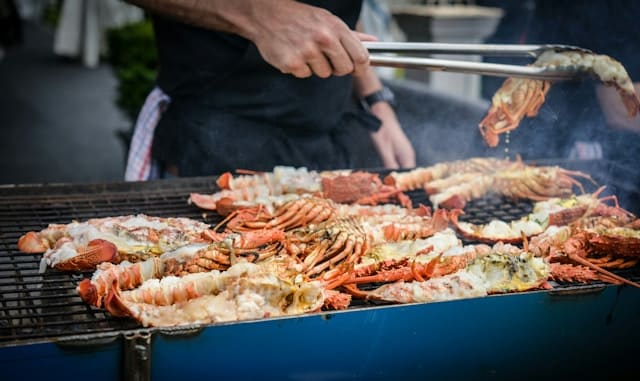Becoming a maestro of the grill is not something that happens overnight. It’s a skill that requires patience, practice, and a solid understanding of grilling techniques. Whether you’re an aspiring pitmaster or a seasoned griller aiming to improve your skills, clear-cut guidance can enable you to grill deliciously succulent and perfectly charred food every time. Today, our focus will be on the quintessential techniques to master for the perfect BBQ. These will include understanding grill types, managing heat and temperature, gauging grilling times, and infusing your food with exquisite flavors that will tantalize the taste buds.
Understanding Grill Types for Optimal Cooking
Choosing the right grill can have a significant impact on the outcome of your BBQ. There are two primary types of grills: gas and charcoal. Each has its unique features and benefits.
Sujet a lire : Gourmet vegan desserts: indulgent and guilt-free
Gas grills are user-friendly, offering a straightforward way to grill. They heat up quickly, have easily adjustable temperature controls, and require less cleanup. They are perfect for quick weeknight grills or for recipes that require consistent temperature.
Charcoal grills, on the other hand, require more of a hands-on approach but reward you with a smoky flavor that’s hard to match. The process of lighting and heating the charcoal can be quite time-consuming. However, the end result is often well worth the effort. Charcoal grills are ideal for low and slow cooking, and for those who enjoy the interactive and rustic aspects of grilling.
Avez-vous vu cela : Gluten-free baking: delicious bread and pastry recipes
Managing Heat and Temperature for Perfect Results
Regulating heat and temperature is a crucial aspect of grilling. It’s not just about high heat— control and consistency are the keys to perfect grilling.
For gas grills, maintaining an even temperature is relatively simple thanks to the adjustable knobs. Always preheat your grill for 15 to 20 minutes before you start cooking. A properly heated grill sears food on contact, keeps the insides moist, and helps prevent sticking.
Charcoal grills require a bit more finesse. You’ll need to create a heat gradient by arranging your coals. For direct grilling, spread an even layer of charcoal underneath the cooking area. For indirect grilling, pile the coals on one side of the grill, leaving the other side free of coals.
Gauging Grilling Times for Deliciously Cooked Food
There’s no one-size-fits-all grilling time for all foods. Different types of meat, vegetables, and other grill-friendly foods require different cooking times. For example, a thick steak might need up to 10 minutes per side, while chicken breasts usually take 6 to 8 minutes per side.
It’s also important to remember that grilling times can vary based on the heat of your grill and the thickness of the food. Using a meat thermometer will help ensure that your meat is cooked to the desired temperature.
Mastering BBQ Techniques for Flavorful Meat
There are a few techniques that can take your BBQ from good to great. One is the use of marinades and rubs. Marinades not only add flavor but also tenderize the meat, while rubs create a delicious crust. Remember to marinate your meat in the refrigerator and not at room temperature.
Another technique is to make use of the grill’s lid. It reduces flare-ups, maintains steady heat, and speeds up cooking. The lid also helps to infuse the food with a smokey flavor, especially when you’re using a charcoal grill.
Lastly, remember to rest your meat after it comes off the grill. This allows the juices to redistribute, resulting in a more succulent and flavorful bite.
Grilling Tips and Tricks for the Best BBQ
Here are some additional tips to help you master the art of grilling.
Firstly, always clean your grill grates before and after grilling. This prevents buildup and helps your food taste its best. You can clean them using a long-handled grill brush.
Secondly, oil your grill grates. This prevents your food from sticking to the grill. Use a pair of tongs, a piece of folded paper towel and a small amount of oil to lightly coat the grates.
Another tip is to avoid flipping your meat too often. This will give it a chance to sear and develop that delicious, caramelized crust.
Finally, never squeeze or flatten meats with a spatula. This will cause the juices to leak out, resulting in dry and less flavorful meat.
The Subtleties of Direct and Indirect Heat
Grilling techniques can be broadly divided into two categories: direct heat and indirect heat. Direct heat is when you cook your food directly over the flames or embers. This method is great for searing and achieving that perfect char on foods like steaks, burgers, and grilled chicken that cook quickly.
In contrast, indirect heat is a method where the food is placed in an area of the grill that is not directly over the flames or coals. This method is slower and more akin to oven roasting, and it’s ideal for larger cuts of meat that need longer cooking times, such as whole chickens or roasts. The secret to success with indirect grilling is patience and consistent heat management.
When using a gas grill, achieving indirect heat is as simple as turning off one set of burners and placing the food over the unlit burners. With a charcoal grill, it’s a matter of piling the charcoal to one side of the grill and placing the food on the other side. Remember, whether you’re using direct or indirect heat, monitoring your grill’s temperature is crucial as it will help you avoid undercooking or overcooking your food.
Adding Smoky Flavor with Wood Chips
No BBQ would be complete without the smoky flavor that comes from the grill. One way to enhance this flavor is by using wood chips. When these chips are heated, they produce smoke which infuses the food with a unique flavor.
Different types of wood chips can lend different flavors to your food. For instance, hickory and mesquite are great for robust flavors, while fruitwood chips such as apple or cherry can give a subtler, sweeter flavor. The wood chips need to be soaked in water for about 30 minutes before you put them on the grill. This prevents them from burning too quickly.
You can use wood chips on either a gas or charcoal grill. For a charcoal grill, simply sprinkle the soaked chips over the hot coals before you start cooking. For a gas grill, you’ll need a smoker box, which is placed on the grill grates.
Conclusion
Mastering the grill is much more than just flipping burgers. It’s about understanding the nuances of heat management, making the most of your grill type, and knowing how to enhance flavors. By following these grilling techniques and tips, you can become a true grill master.
Remember, practice is key. Don’t be disheartened if the results aren’t perfect the first time. Take note of what worked and what didn’t, adjust your techniques accordingly, and have fun while you’re at it! Because at the end of the day, the joy of grilling lies not just in the delicious food you create, but also in the process of creating it.
So fire up your grill, whether it’s gas or charcoal, and start practicing these techniques. From managing heat and temperature, to gauging grilling times, to enhancing flavors with marinades, rubs, and wood chips, you have plenty of tools at your disposal. And with a clean grill, a trusty meat thermometer, and a toolkit of grilling tips, you’re well on your way to perfect BBQ.






